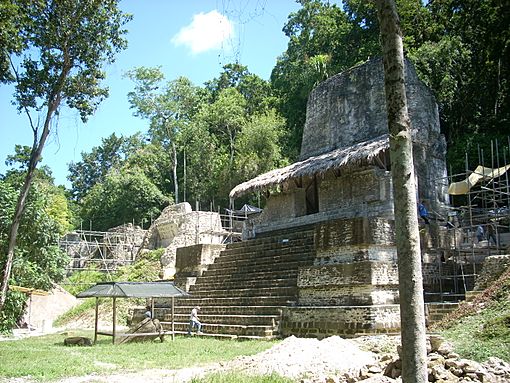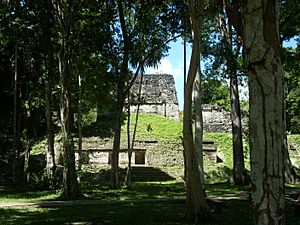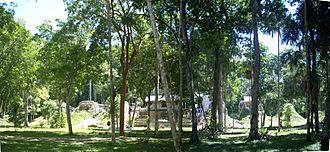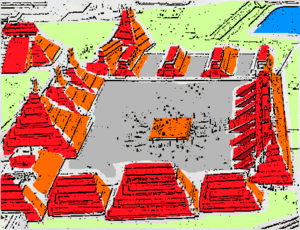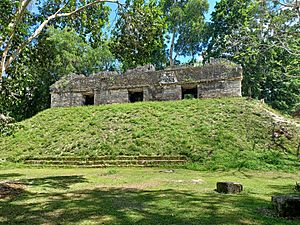Plaza of the Seven Temples facts for kids
The Plaza of the Seven Temples (also known as Plaza de los Siete Templos in Spanish) is an amazing ancient area in the ruins of the Maya city of Tikal. Tikal is located in northern Guatemala. This plaza gets its name from a line of seven small temples built a long time ago, between 600 and 900 AD. It's one of the three biggest open spaces in the city, covering about 25,000 square meters (that's like 6 football fields!). You can find it southwest of the famous Great Plaza, and right next to the Mundo Perdido ("Lost World") Complex.
Contents
History of the Plaza
This section tells you about the different times the Plaza of the Seven Temples was used and changed.
Early Days: The Preclassic Period
The very first signs of people using this area go way back to around 650 BC. Archaeologists found thousands of broken pottery pieces buried in the ground. These pieces show that people were here, even before any big buildings were made.
The first actual buildings in this area were part of a temple complex facing the Lost World Plaza. This happened between 650 and 550 BC. Later, around 400 to 200 BC, people started living in the plaza itself. The first structure built right in the plaza was a small round platform, only about 12 centimeters (5 inches) high and 4 meters (13 feet) wide. It might have been an early home or a special altar.
For a long time, the entire Plaza of the Seven Temples wasn't covered with a smooth floor. Instead, floors were laid around the important buildings nearby. The plaza was more like an open space between other big areas, like the South Acropolis and the Lost World Complex.
Busy Times: The Classic Period
Archaeologists believe a lot of building happened in the plaza during the Early Classic Period (around 200 to 600 AD). We know this because they found many pieces of pottery from that time.
The Plaza of the Seven Temples as we see it today was mostly built during the Late Classic Period (about 600 to 900 AD). This is when some of the main buildings on the south side were constructed. The plaza was used right up until the city of Tikal was left empty.
Modern Discoveries: Digging Up the Past
People started studying the plaza in modern times. In 1963, a researcher named Patrick Culbert began looking at the different layers of earth to understand its history.
Big excavations (digging up ancient sites) started in 1983. The goal was to make the seven temples and a palace structure stronger so they wouldn't fall apart.
Later, in 2004, a joint project between Guatemala and Spain began. They had many workers who carefully dug up and restored the buildings. They worked on the southern palace buildings in 2005, the seven temples in 2006, and even a special triple ballcourt in 2007.
How the Plaza is Set Up
The Plaza of the Seven Temples is divided into different sections, like rooms in a giant outdoor house. The main path through the plaza used to run from the ballcourt in the north to the palace building in the south. The seven temples were added later, using the side of a nearby hill.
Here are the different parts of the plaza:
- The Central Patio: This is the main open area in the middle of the plaza. It's like a big courtyard surrounded by buildings. It covers about 8,000 square meters (almost 2 acres). The seven temples line up along its east side. A palace complex is on the south, and a triple ballcourt is on the north. The west side is bordered by another temple complex.
- The North Patio: This is the area just north of the triple ballcourt.
- The East Patio: This area is right behind the seven temples. It's actually a flat part of the South Acropolis. Some of its walls are very old, dating back to the Preclassic Period.
- The South Patio: This is the area south of the big palace building.
The west side of the plaza is closed off by the remains of an ancient temple complex that faces another plaza.
The Seven Temples
These seven temples give the plaza its name! They are lined up neatly along the east side of the plaza. They are called Structures 5D-93 through 5D-99.
- Structure 5D-94: This is the second temple from the south end. It stands about 2.3 meters (7.5 feet) high.
- Structure 5D-96: This is the biggest of the seven temples, standing about 2.5 meters (8 feet) taller than the others. It's the central temple in the row. In front of it, you can see a plain stone monument and an altar. This temple is special because it has cool relief sculptures, including a skull and crossed bones! In 2004, workers cleared away plants to protect the temple, as tree roots were damaging its top parts.
Other Important Buildings
On the south side of the plaza, there are three large palace-like buildings: Structures 5D-90, 5D-91, and 5D-92. These three buildings were connected to form one big structure.
- Structure 5D-90: This is the westernmost building. It's shaped like a rectangle and has five doorways on both its north and south sides. It probably had decorated walls. This building was built during the Late Classic period and changed later. It originally had two rooms, but these were divided into five smaller rooms. Some of these rooms might have been used as homes, while others were for official business. Archaeologists found almost 23,000 pieces of pottery and other items like bone, shell, jade, and obsidian around this building.
- Structure 5D-91: This is the central and largest building on the south side. It's a grand structure with steps leading up to it on both the north and south sides. It has been restored by archaeologists. This building originally had a long hallway that was later divided into three rooms. What's really cool are the small sculpted masks on its corners and possibly in the middle. It also has a small decorative top part called a roof comb with ten more masks! These masks show feather decorations and necklaces. Structure 5D-91 was built during the Late Classic period.
- Structure 5D-92: This is the easternmost building and has three doorways on its south side.
On the north side of the plaza, there are structures (5D-77 to 5D-81) that might have formed a triple ballcourt. This is where the Maya played their famous ballgame!
Stone Monuments
The plaza doesn't have many stone monuments. There is a plain stone monument called Stela 37 and an altar called Altar 31. These were placed in front of Structure 5D-96, the largest of the seven temples.
Ancient Burials
Archaeologists found a few burials in the plaza:
- Burial 1: This burial was found in the central part of the plaza. It's thought to be from the Early Classic Period.
- Burial 2: This burial was found in the south patio.
- Burial 3: This burial was found close to Burial 2, also in the south patio.


